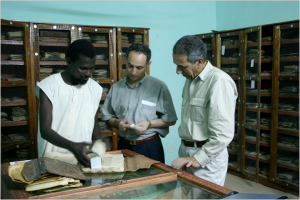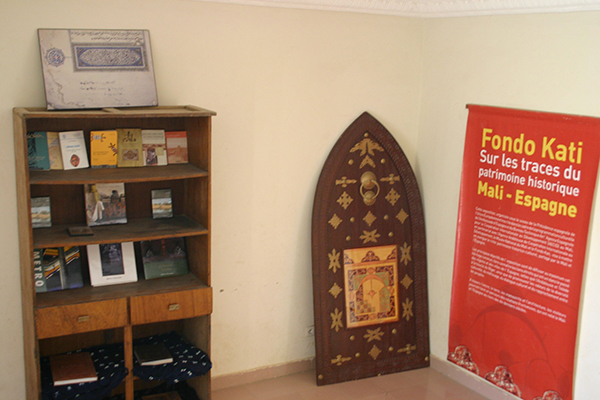
The Fondo Kati, also known as the Biblioteca Andalusí de Tombuctú, was officially opened on September 27 2003, with generous funding from the Spanish regional government of Andalucia because of the links of the Kati family, the founders of the library, with Spain. The library was started by Ismael Diadié Haidara, descendent of Mahmud Kati, the famous Timbuktu chronicler renowned for his Ta’rikh al-Fattash. Ismael claims that his paternal family descends from Roderique the Goth, the Christian ruler of Spain at the time of the arrival of the Arabs under the leadership of Tariq ibn Ziyad. The Christian rulers were split over whether to welcome the Arabs or to oppose them and he explains that his ancestors welcomed the Arabs and were amongst the first to embrace Islam. His ancestor ‘Ali ibn Ziyad, finally left Andalusia in the 1460s and settled in the village of Goumbou, on the border of Mauritania and Mali. ‘Ali ibn Ziyad married Khadija, sister to the Songhai ruler, Askia Muhammad. In this way, Spanish, Arab and African lineages were mingled and finally found abode in Timbuktu.

The library housed the manuscript collection and Ismael’s office, in addition to an exhibition hall and lodging facilities for visiting scholars. Ismael’s collection of manuscripts was gathered from the various branches of the Kati family. He endeavours to collect manuscripts that deal with his Spanish ancestry and concentrates mainly on works written by scholars from his own clan, in whose footsteps he follows. He is an accomplished scholar in his own right, having completed his undergraduate studies in Mali and Spain.
Ismael’s collection comprises about 12 000 manuscripts that are arranged according to fonds (collections) belonging to the different family members who wrote marginal annotations on the manuscripts. There are currently 82 fonds, from ‘Ali ibn Ziyad to that of Ismael himself. The abundant family marginalia of the collection have received much scholarly attention.
During the 2012 crisis, the Fondo Kati was one of the collections that chose to remain in Timbuktu, however, removed from the library building and hidden away from view. The majority of the Timbuktu manuscripts were removed from the town to Bamako by SAVAMA-DCI, where they are now receiving intensive treatment through digitisation and conservation, funded by a large number of international sponsors. Ismael self-exiled to Spain, where he is raising funds and awareness for the conservation of his collection.